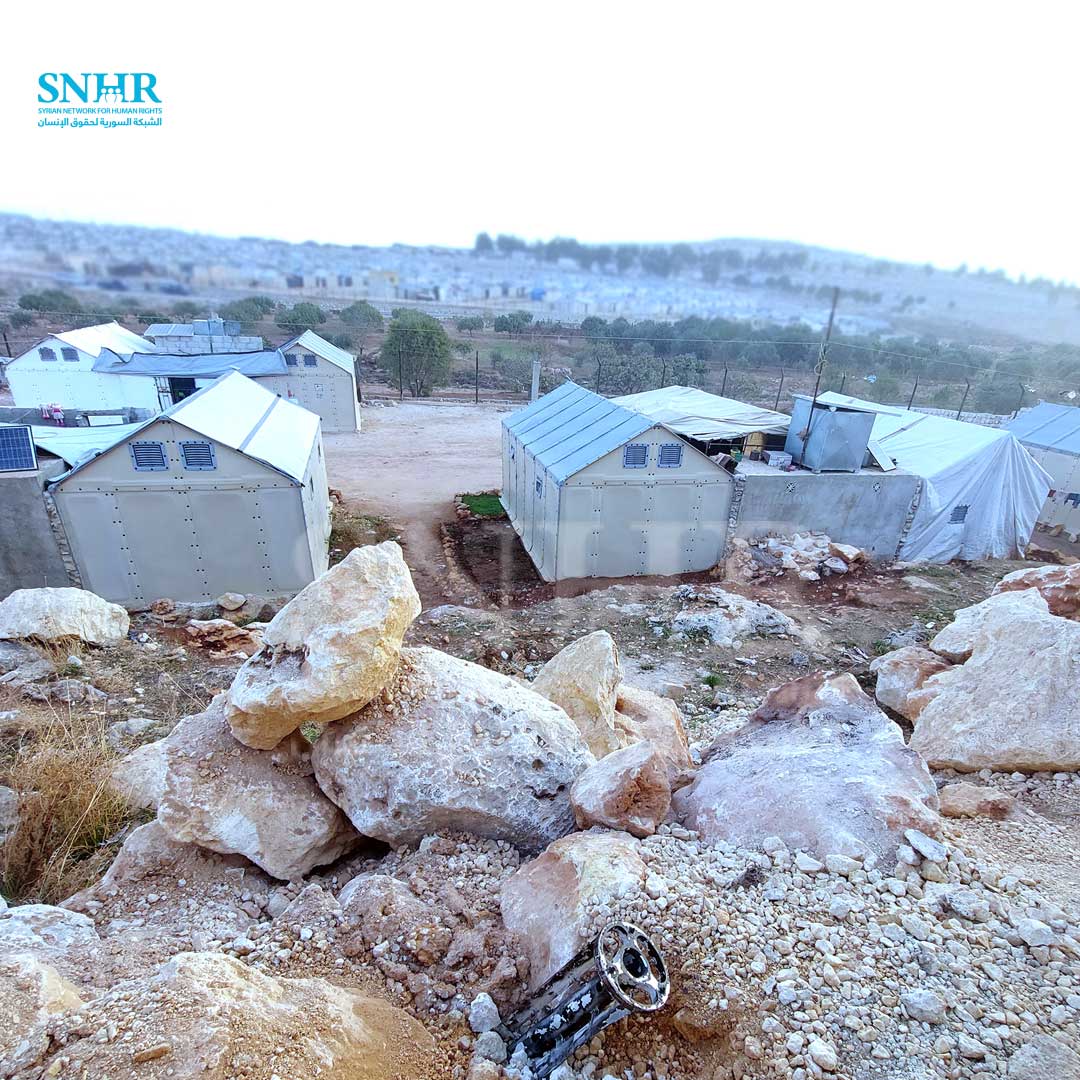Russia Backed the Syrian Regime in the Attack

Remnants of a 9M27K1 rocket used by Syrian regime forces in a cluster munition attack on the IDPs camps in northwestern Idlib city on October 6, 2022
Languages
Available In
Press release: (Download the full report below)
Paris – The Syrian Network for Human Rights (SNHR) today released a report entitled, ‘Investigation: The Syrian Regime Used Cluster Munitions to Target a Group of IDP Camps in Northwestern Idlib city’, in which the group stressed that Russia backed the Syrian regime in the aforementioned attack.
The report uses an investigative approach, based on the collection, analysis and interpretation of evidence, the corroboration of data, and a number of first-hand accounts from witnesses. The report notes that the investigation of cluster munitions attacks has a different character to that used in investigating other types of attacks involving other munitions, due to the nature of the weapon used, and how cluster bombs explode and scatter submunitions over wide areas. The report explains that SNHR’s team faced various challenges during the course of this investigation, including those posed by the fact that the targeted area houses IDP camps, some of which were irregular in nature with no previous maps or photos available to refer to in the documentation process. Furthermore, the area adjacent to the camps, Ahrash al-Bassil, is of a military nature, making it difficult to access. Additionally, some of the residents had transferred bomb remnants from the attack to other areas or already disposed of them, particularly the shells containing the rockets, which made it difficult to pinpoint the exact location where they landed.
As the report recounts, the attack took place on November 6, 2022, in the hilly area to the west and northwest of Idlib city, where a group of IDPs camps can be found – most notably: Maram, Watan, Wadi Khaled, Mahattat al-Meyah/Kafr Ruhin, Murin, al-Eman/Kafr Ruhin, and B’ieba. Those camps extend from southwestern Kafr Jales town to Murin village and Sahl al-Ruj. Ahrash al-Bassil, a forested area located in the southwest of this region, covering approximately two kilometers that houses camps for Hay’at Tahrir al-Sham (HTS) personnel. In 2013, armed opposition factions managed to take control of the area, before it was completely taken over in 2017 by HTS. The area was under the joint control of armed opposition factions and HTS at the time of the attack.
The report reveals that a 220mm BM-27URGAN rocket launcher stationed in an area under the control of Syrian regime forces and Iranian militias, suspected by the SNHR team suspects to be the al-Nayrab Military Airbase, was used to fire 9M27K1 rockets carrying 9N235 submunitions. According to the SNHR team’s exhaustive investigations and analysis of the remnants left by the attack, we suspect that eight missiles were fired in the attack. These rockets exploded successively in the skies over the hilly area housing camps to the northwest and west of Idlib city and Ahrash al-Bassil. The report documents that no fewer than 11 individuals – nine civilians, including four children, two women, and an unborn fetus, as well as two HTS fighters – were killed in the attack targeting the Ahrash al-Bassil area. In addition, about 75 other people, mostly civilians, were injured. Most of the fatalities were documented in the Maram IDP Camp. Furthermore, the report notes that around 7,500 civilians fled their residences in the aftermath of the attack.
The report pinpointed 29 of the sites where cluster munitions landed. Of those 29 sites, 26 were located in four of the IDP camps, where the attack caused various forms of material damage. Those camps are, Maram, Wadi Khaled Mahattat al-Meyah/Kafr Ruhin, and Murin, with Maram being the most heavily damaged in the attack, with the report providing details of the damage sustained.
The report proves the Syrian regime’s responsibility for the attack, and confirms that the regime received logistical support from Russian forces in the ir. Moreover, the report stresses that the use of cluster munitions by Syrian regime forces, under the leadership of the Commander-in-Chief, Marshal Bashar Assad, and by Russian forces violates both the principles of distinction and proportionality according to international humanitarian law, thereby constituting a war crime.
The report adds that the cluster munition attacks on IDP camps and civilian gatherings have created a state of terror and fear among the displaced, substantially exacerbating their already-catastrophic situation, with these dispossessed people already suffering excessively due to an extremely poor humanitarian response.
The report calls on the UN Security Council to take further action after the adoption of resolution 2254, which explicitly “demands that all parties immediately cease any attacks against civilians and civilian objects as such.” The report further asserts that the Security Council must issue a special resolution prohibiting the use of cluster munitions in Syria, as with the existing prohibition of the use of chemical weapons, adding that this resolution should also address how to remove the remnants of these lethal weapons.
Furthermore, the report calls on the UN General Assembly to hold the Russian and Syrian regimes responsible for this attack, and put pressure on the Security Council to take action to protect the Syrian people, and prevent Russia from claiming impunity simply on the grounds of its status as a permanent member of the Security Council. The report also calls on the Syrian regime to cease the killing of Syrian citizens and respect the Syrian constitution and international law, as well as to adhere to the rules of customary international humanitarian law, stop perpetrating crimes, and compensate the victims affected in this attack, in addition to making other recommendations.


